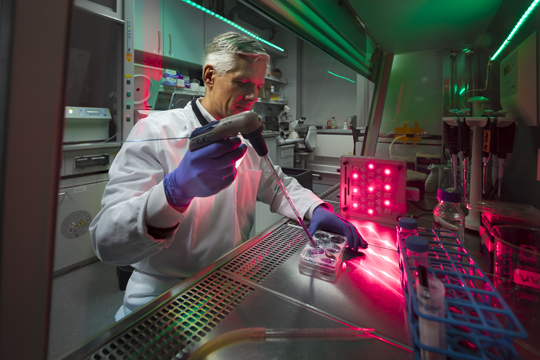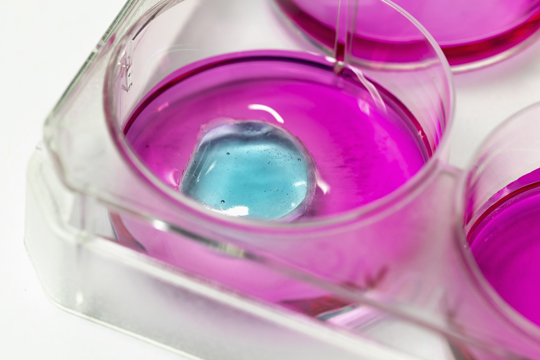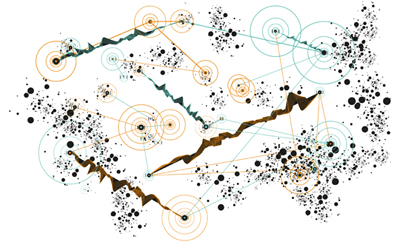“Spaghetti” gel acts like tissue
Freiburg, Sep 23, 2019
Professor Dr. Wilfried Weber hitches molecular, light-sensitive switches to other molecules. In the CIBSS – Centre for Integrative Biological Signaling Studies at the University of Freiburg, he has created a gel which changes state from hard directly to soft, depending on the light. Weber and his collaborative partners aim to use this tool to enable certain immune cells to penetrate hard tumors and combat them from inside.

Wilfried Weber has developed a special gel that can be switched from hard to soft within seconds, using light. Photos: Jürgen Gocke
Some immune cells try to push the living tissue aside to get into solid tissue – as if trying to pass through dense bamboo thickets without a machete. “How hard can they push?” Wilfried Weber wants to know. A biotechnologist and part of the CIBSS Excellence Cluster’s representative team, he interested in molecular slide switches. Together with his CIBSS partners, he hopes to find these signaling pathways and learn to control them. This would enable human immune cells to penetrate and fight hard tumors which would otherwise have defeated them. Weber's research group is building molecular tools for this and other projects. To simulate the tissue, Weber has developed a special gel that can be switched from hard to soft within seconds, using light.
Sticking together macromolecule chains
“It looks like a plate of spaghetti,” says Weber. When the pasta is properly cooked, a fork can stir it easily. But it's a lot more difficult if the spaghetti is stuck together by a lot of cheese. Weber, of course, works not with spaghetti but with chains of macromolecules, also known as polymers. Instead of cheese, he adds light-sensitive switches. Depending on the strength of red light, the switches bind and link up the molecule chains to a greater or lesser extent. The chains form a loose or more solid gel. Conversely, dark red light dissolves the bonds. The gel softens and may even liquefy.
“For example, doctors might one day implant a gel into patients and release the drugs in it at the desired time,” Weber says. This molecular toolmaker, who completed the trinational biotechnology course in Freiburg-Strasbourg-Basel, is doing basic research. But, he says, “it is my great wish that one day one of our tools will contribute to the benefit of people - for example, by improving the treatment of a disease.
|
Biological signals and signalling pathways Precise coordination is needed in order for trillions of cells to form, maintain and regenerate orderly tissues, organs and healthy organisms. To achieve this, complex communications processes take place between and within cells. Defects in these communications networks can lead to developmental disorders, immunodeficiency, cancer and other diseases. The CIBSS Cluster aims to achieve a comprehensive understanding of these communications processes – from the molecular level to the level of cells and organs. Furthermore, CIBSS research groups will investigate how these communications processes are connected to other important biological processes such as metabolism. Based on these new findings, the researchers will develop new possibilities to address challenges in areas as diverse as immunotherapy and the sustainable production of crops.
|
|
Switchable gels have been around for some time, but conventional gels change their consistency depending on heat, chemicals or pH. Cells do not tolerate this at all. That's why Weber uses biological protein switches, saying “We let nature inspire us.” His light-sensitive switches, for example, are photoreceptors from plants and bacteria. Weber attaches these proteins to biomolecules, mostly other proteins, but also to macromolecules or analysis chips. He can switch the coupling products on and off. Control signals are natural or manmade substances, or – in the use of optogenetics – light. Light can issue an order to transcription factors, for example, to read certain genes; to make proteins start or interrupt certain signaling pathways - or to stick molecular threads together, in the case of switchable gels.
Skillful irradiation creates easy pathways for immune cells
Weber finds it relatively easy to combine different proteins: “To do this, we link up their genes and introduce them into cells, which then produce the fusion protein.” However, the researchers have to connect their protein switches to macromolecules themselves. For the “spaghetti” gel, Weber uses the red light receptor Cph1 from blue-green algae. “We had to produce grams of it,” he says. This is followed by the combination of two chemically different substances - Cph1 protein and polymer threads made of polyethylene glycol. Chemists like to cook up mixtures like this to create bonds. Sometimes they add aggressive acids or bases. But proteins do not tolerate this. “We had to do a lot of optimization until the bonding was successful and the gel circuit worked,” says Weber, “We did a lot of pioneering work in this area.”
Depending on its state, the gel imitates the properties of denser or lighter tissue. Weber has tested this in his work with Professor Wolfgang Schamel and Dr. Susana Minguet, both from the Institute of Biology III at the University of Freiburg. “We applied T-cells to the surface of the gel and applied an attractant for these cells in the gel,” Weber says. T-cells are immune cells that normally migrate through the body, hunting down enemies. T-cells are able to cope effortlessly with loose tissue and gel, but not with very solid tissue. “In the gel, we can even control the route of the cells by exchanging a few parts.” Skillful irradiation creates soft paths in hard areas.

The gel (blue) acts as artificial tissue – the researchers influence its mechanical properties and observe the condition needed for immune cells to pass through.
The spaghetti gel has another trick: Cph1 molecules can not only tie macromolecules together – the light-switches also have attachment points for T-cells. “This enables the immune cells to tug on the polymers,” says Weber, describing the result of his CIBSS cooperation with immunologists Schamel and Minguet, T-cells want to remove obstacles and try to find their way. How much strength do they have? Do they need time to adapt to environments of various densities? Which signaling processes are responsible for pulling and adapting? Science knows little about this.
“Each switch is also a sensor”
The CIBSS cooperation is therefore primarily concerned with how mechanical tissue properties influence the migration of T-cells. Can Weber and his colleagues give them new strength and get them to break through hard barriers? The long-term goal is to prevent solid tumors from mechanically blocking T-cell attacks. Maybe in the distant future, says Weber, who completed his doctorate and habilitation theses at ETH Zurich. He is a co-founder of a company seeking better treatments for tuberculosis. The method - which was successful in the test tube ten years ago - is still making its way to hospitals.
Weber, who has been Professor of Synthetic Biology in Freiburg since 2009, has another ace up his sleeve: “Each switch is also a sensor.” They are particularly useful as feelers for chemical markers in medical diagnostics. One of Weber's collaborations has produced a chip that can determine the concentration of an antibiotic in the blood within five minutes. This enables doctors to give patients the optimal amount of medication at any time. Wilfried Weber has already taken one step towards his desired goal of benefiting human health.
CIBSS – Centre for Integrative Biological Signaling Studies
CIBSS is one of the two new Clusters of Excellence at the University of Freiburg. In CIBSS, more than 60 working groups will investigate biological signalling processes of immune cells and mitochondria, and in organ development and in plant roots. The researchers come from six faculties – for Biology, Mathematics and Physics, Medicine, Chemistry and Pharmacy, Engineering, and Law. The University Medical Center and the Max Planck Institute of Immunobiology and Epigenetics are also participating in CIBSS. The German Research Foundation (DFG) is funding the Cluster from the beginning of 2019 until the end of 2025.
CIBSS – Centre for Integrative Biological Signaling Studies


